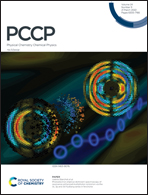A reduced electrophilicity for simple Lewis acids A involved in non-covalent interactions with Lewis bases B†
Abstract
Dissociation energies De for B⋯A = B + A can be written De = c′NBEA, where NB and EA are the nucleophilicities and electrophilicities of the Lewis base B and the Lewis acid A, respectively. A reduced electrophilicity is defined ΞA = EA/σmax, where σmax is the maximum electrostatic surface potential on iso-surface of A, the atom directly involved in the non-covalent interaction. This definition is tested for halogen-bonded complexes B⋯YX, with Lewis bases B = N2, CO, C2H2, C2H4, H2S, HCN H2O or NH3. De plotted against NB for several series B⋯YX yields straight lines of gradient EA. When De/σmax is the ordinate, the straight lines conflate to a single line, gradient ΞIX = EIX/σmax. Hydrogen-bonded complexes B⋯HX (X = F, Cl, Br, I), coinage-metal complexes B⋯MX (M = Cu, Ag, Au; X = F, Cl, Br, I), and alkali-metal bonded complexes B⋯MX (M = Li, Na: X = F, H, CH3) behave similarly. ΞA is an intrinsic property of the atom immediately involved in the non-covalent bond.



 Please wait while we load your content...
Please wait while we load your content...